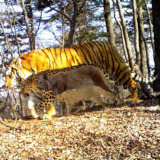Cave Lions...What The? · 1:53am Mar 12th, 2021
Imagine if you could enter the mammoth's realm. A place of freezing temperatures and wide-open spaces. Massive herds of bison, camels, and horses grazing on the oceans of grass. Now imagine something in the grass, looking for weakness, what would appear to be a lion...but not quite. Meet the Cave Lion "Panthera spalaea". Cave Lions were a species of big cat ranging from Western Europe all the way to Canada that, contrary to what the name would suggest, did not live in caves nor was it actually a lion. Cave Lions were genetically distinct from modern lions and a recent study found that there were two cave lion subspecies, one in Western Eurasia and the other in Eastern Eurasia, Beringia, Alaska, and Canada.
Like with the more famous Smilodon, it is somewhat debated whether or not cave lions were social hunters or solitary like modern tigers or leopards. The general agreement appears to be that unlike modern lions cave lions were solitary. The reasoning comes from a study that analyzed the bone collagen of cave lion bones to see what they were eating. This is the conclusion the authors came to.
"In the Western population, cave lions were dominated by the social cave hyenas, and cave wolves (Canis lupus spelaeus) after the cave hyena’s extinction, where their ranges overlapped based on isotopic tracking. Cave lions were restricted to mainly hunting reindeer (Rangifer tarandus) and other cervids based on isotopic data, while cave hyenas included roughly equal amounts of all large herbivores. [18] In Africa, the social organization of lions has allowed them to resist spotted hyenas (Crocuta crocuta crocuta) and African painted dogs (Lycaon pictus) and this not being the case in Europe reflects a possible difference in lion behavior that leaves them more vulnerable to social competitors, such as being generally solitary."
These findings I am actually pretty skeptical of because to me, it just doesn't add up.
The method used in the study used bone collagen which was and to this day is the more popular method of studying the diets of extinct Cenozoic animals. However, it's now known that looking at the teeth rather than bone collagen is more reliable simply because they less likely to be messed with while being fossilized. A study using the teeth when looking at the diet of Smilodon revealed it was hunting browsing animals like tapirs. This is very different from earlier studies using bone collagen that concluded Smilodon hunted horses, bison, and camels. In other words, if a new study conducted on cave lion diets using the teeth, it may produce very different results.
The next question that needs to be asked is what habitat did cave lions live in? This is important because the habitat is the reason modern lions live in prides. Living in a group has many advantages out on the grasslands, but the main reason is thought to be to defend territory as it's much easier to see rivals in grasslands and thus fights would break out more frequently, and the biggest prides have the best hunting grounds. The habitat of cave lions was the mammoth steppe, a huge grassland that stretched from Spain all the way to the Yukon territory with not a lot of trees, if any. The perfect place for a lion-sized cat to form a group structure, especially if they're competing with clans of hyenas.



I don't know much on the subject, but you're right. It doesn't add up.